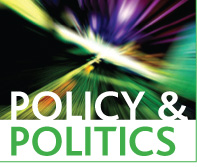Cristina Leston-Bandeira
 This section of Discover Society is provided in collaboration with the journal, Policy and Politics. It is curated by Sarah Brown.
This section of Discover Society is provided in collaboration with the journal, Policy and Politics. It is curated by Sarah Brown.
E-petitions have become extremely popular over the last decade. They circulate freely and quickly, with most people at some point having signed one. But there is a perennial question associated with them: what’s the point of e-petitions, do they achieve anything? In my recent Policy & Politics article, I approach this issue by exploring the different roles e-petitions can play, focusing on e-petitions to parliament. I show that petitioning systems perform roles beyond enabling participation and policy change, depending on the types of processes in place to evaluate them. I demonstrate that the processes through which e-petitions are considered are crucial in shaping the role(s) they perform.
The evaluation processes used tend to shape the roles performed by petitioning systems. Petitions are a hook for further action: they are meaningless on their own. What matters is how they are considered by parliament and what results from this, if anything. Assessments of whether petitions achieve anything need to be developed within the context of what happens to them beyond the collection of signatures. Linked to this, it is also important to take a long-term view to understand the effect of a petition. The effect of a petition doesn’t finish with the collection of signatures, nor with, say, a debate. Just as with any other political process, in order to evaluate the impact of a petition, one needs to consider its effect on the actors involved and any subsequent actions, which can take place within days but may also last years. Such is the nature of affecting change in politics.
My article presents an historical and comparative analysis of different parliamentary petitioning systems and identifies four types of roles performed by these: linkage, campaigning, scrutiny and policy. Each of these types includes a wide range of specific roles from fire-alarm and safety-valve to changing policy (see table below). These different roles interlink, with scrutiny often contributing towards policy, for instance, just as linkage roles can be closely intertwined with scrutiny. Mediation between citizens and policy-making rarely happens through isolated actions; i.e. far from a neat unidirectional process, mediation between citizens and policy-making encompasses formal and informal processes, whereby linkage, campaigning, scrutiny and policy, intertwine. Petitioning systems have the potential to impact on all of these.
Roles performed by parliamentary petitioning systems
| Types | Roles |
| Linkage | · Legitimacy;
· Safety-valve; · Grievance resolution; · Education; · Public engagement; · Political participation; |
| Campaigning | · Mobilisation;
· Group identity strengthening; · Dissemination; · Recruitment; |
| Scrutiny | · Fire-alarm;
· Agenda-setting; · Evidence gathering; · Questioning; |
| Policy | · Policy review;
· Policy improvement; · Policy influence; · Policy change. |
The extent to which a parliamentary petitioning system performs any of these roles is dependent on the processes it entails. To illustrate this, my article develops an empirical analysis of the roles performed by the UK Parliament’s e-petitions system in its first parliament, 2015-2017. To date, this is the world’s parliamentary petitioning system with the highest volume of usage, in terms of the number of petitions submitted and of signatures collated, as demonstrated in the article. This makes it a particularly interesting case study to examine. This study’s empirical analysis is based on interviews with petitioners, parliamentary staff and MPs, as well as ethnographic observation of parliamentary sessions and analysis of petition data, amongst other.
My analysis shows that the UK Parliament’s e-petitions system performed a variety of roles, namely scrutiny and campaigning, but that its main role was in public engagement. The processes used to evaluate the petitions submitted were crucial in shaping these roles.
The system was introduced in 2015, collaboratively with the UK Government, with the intention of redressing problems with previous Government-led e-petitions systems. A core part of the new system was the establishment of a Committee that managed and oversaw the e-petitions system. The existence of a Committee of MPs, led by a Chair, and supported by a team of staff, was found to make a significant difference to the new system. This enabled those e-petitions that attracted the most signatures to be followed up where appropriate. The Committee can lead inquiries, debate petitions and initiate any other activity which enables it to better understand the arguments surrounding a petition.
Simple methods, such as emailing all signatories of a petition every time an action was taken, meant that signatories stayed informed about their petition beyond signing. Additional public engagement activities, such as deliberative workshops, digital forums and surveys, all helped the Committee to understand better the reasoning behind petitions, and to draw on this insight during parliamentary proceedings. The regular communication with petitioners had another effect: petitioners felt someone was listening to them. In interviews, petitioners repeatedly talked of their surprise when the Committee got in touch with them.
Regardless of whether they had achieved what they were after, petitioners were positive about the experience of petitioning if they felt they had been listened to. The wide range of public engagement initiatives held by the Committee meant that many people who would not otherwise have been involved with Parliament, became involved by submitting or signing a petition, following a debate or participating in a public engagement initiative led by the Committee. One of the interviewees for this research, for example, had never voted and had little understanding of what Parliament entailed, until they decided to submit a petition because they were so frustrated with a specific situation. Public engagement was therefore a key role performed through this petitioning system.
But the system also performed other roles such as scrutiny, again thanks to the processes in place. All petitions obtaining 10.000 signatures receive a government response; likewise a debate takes place for most petitions obtaining 100.000 signatures, which ensures a response from the relevant minister at the debate. This ensures the government’s position on the issues raised by petitions are put on the record, alerting MPs to issues that may need following up. As there is a Committee supporting the process, this means that responses by the government deemed unsatisfactory can be followed up by MPs.
For example, it was dissatisfaction with the Government’s response to a petition on brain tumour research funding that led the Committee to decide to conduct an inquiry into this issue. This is a good example of the importance of having a Committee that follows up issues. In this instance, a wide range of steps were taken following the inquiry in 2015, up to 2019 when the Health Secretary of State was called back to the Committee to give evidence on the subject. By integrating the Government into the petitioning process, the system facilitates clearer paths for scrutiny than other systems may do. The article explores this in more detail, including ways in which the system has performed a policy role.
However, just as the processes enable the performance of specific roles, they can also hinder them. Although interviewees for this study were generally positive about their petitioning experience, when the debates did not focus on their petition and simply followed traditional party-political lines, there was a sense of great disappointment. Besides this, a high volume of petitions are rejected (65.5%), with only a very small proportion leading to any action (about 5% of those accepted). What’s more, the site favours the most popular petitions: the more signatures an e-petition gains, the more visible it becomes. Thus, the vast majority of e-petitions submitted are not viewed by potential signatories, with most receiving few signatures.
Whilst our study has demonstrated a range of roles played by the e-petitioning system, it focuses mainly on those petitions achieving 100.000 signatures. Future research should investigate all e-petitions and survey all petitioners for a more comprehensive analysis. While the system has capacity to perform specific roles, it may also have a negative-effect on these, for example, by causing disappointment to thousands of petitioners whose petition is in effect invisible due to very low numbers of signatures.
We conclude therefore that any analysis of petitioning systems should go beyond the point of collection of signatures, or even a single instance of a debate in parliament (often seen as the only output of a petition). It is the longer-term consequences of raising specific issues through a petition, and how this is taken forward through formal evaluation processes and actors, that enables our understanding of the extent to which a petition does make a difference.
Cristina Leston-Bandeira is professor in the School of Politics and International Studies at the University of Leeds. She is Co-Director of the Centre for Democratic Engagement and Chair of the UK Study of Parliament Group.
